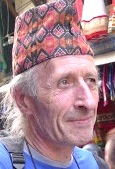
NOTEBOOK
Steve Allin
International Hemp Building Association (IHBA) Director Steve Allin reflects on his visit to Nepal earlier this month where he’s working on hemp building projects with Dhiraj K. Shah, Founder of Shah Hemp Inno-Ventures (SHIV).
The potential for hemp building in Nepal is as great as in any other region of the world. But in Nepal, the material is already there, growing wild in the mountains. In addition to this “wild crop” that can be used to repair and build new homes in the mountains, hemp is also grown for fibre in the far west regions of Nepal.
When I first visited Nepal 30 years ago hemp was literally growing everywhere, at the edges of the fields and behind houses and shops in the city. But with the growth of urban sprawl, many of those fields are buried beneath suburbia and there are far fewer bits of waste ground behind buildings in the city nowadays.
Surveying quake damage
My first day was spent traveling from Kathmandu to the remote village of Sano Palati in the region of Sindhupalchok. It was an eight-hour drive round trip to see first-hand the damage of last year’s earthquake. Nearly all the buildings were damaged — from complete collapse to severe cracking. But it was mainly the fear of the inhabitants that I will remember. Many of them still sleep in tents as they are scared buildings might further collapse from the aftershocks. They were very concerned when I went into one of the buildings to take a few photos.
Greening a hospital
We travelled south the next day to the city of Janakpur, from where Dhiraj’s family originates. His father, Dr R.K. Shah, is building a new hospital to increase the services offered by his clinic in the city. Much of the main building is already erected but the decision was made to build the walls and roof of the waiting area, and some accommodation rooms for staff, using hempcrete.
Dr. Shah was very excited about the potential of “greening” his hospital for future savings and already has a plan in place to use solar energy to light the facility.
The build
As anyone who has ever been to the Himalayas knows, it is a vast area of largely roadless terrain, so transportation is an issue. We had a small sample stock of dried hemp stems from the mountains but they had to be chopped by hand as the decorticator had not been delivered at that stage. In the future, SHIV will be taking their decorticator into the mountains to process the hemp and make it more transportable by greatly reducing the bulk.
Using Indian lime and a variety of additives available locally, we cast some test blocks and decided on which mix we would use for the walls. We found that brick dust worked well and the lime on its own was also good.
More supplies of hemp are now being collected and the decorticator will be delivered soon. The hospital will provide an excellent example of the use of hempcrete. And the mountainous villages provide the opportunity to use not only hemp but other natural building techniques to help repair the damaged houses, and to build new ones.
This is one of two projects we are undertaking with SHIV, with the second one on the plains near the Indian border.
